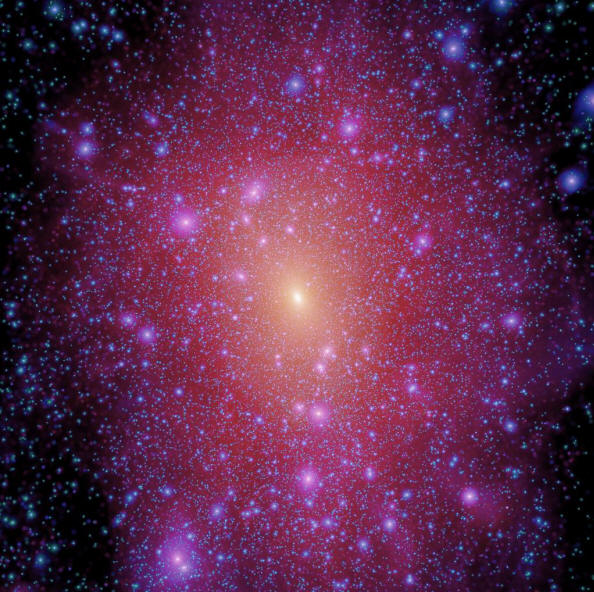|

Dark matter density in a
simulated galaxy halo. Credit: Max Planck
Institute for Astrophysics
MACHOs and WIMPs
Jul 09, 2010
According to cosmologists,
the Universe is made mostly of dark
matter and dark energy, but they do
not know what either is.
A recent
press release opens with
this question: "Dark Matter Detected
for First Time?" It seems ironic to
ask, since what they are "detecting"
has been one of the most all
pervasive, yet most highly
speculative investigations since
phlogiston.
In previous Pictures of the Day,
it was noted that dark matter is an
ad hoc
theory, an addendum to the
gravity-based model of the Universe.
As consensus physics proposes,
without adding dark matter there is
insufficient gravity in the cosmos
to account for galaxies bunching
together. Without sufficient mass,
they should also have decelerated
over the eons instead of moving
through space at 90% of light speed.
An exotic form of matter was
proposed when astronomers realized
that stars traveled around the edge
of a spiral galaxy with the same
angular velocity as stars close to
the center. This was a quandary,
since according to Newton's theory
they should be slower. Therefore,
astronomers assumed that a form of
dark matter was imparting extra
gravitational energy to the stars.
It was called "dark" because the
theory states that it cannot be
detected, except indirectly.
This unseen matter is said to be
sustaining all galaxies, preventing
them from flying apart. Over the
years, research groups have been
trying to reconcile the lack of mass
in the Universe, particularly in
galaxy clusters, with their
recessional velocity.
There is not enough gravity in the
visible stars and gas clouds to
account for that velocity, as well
as the consolidation of individual
galaxies and clusters.
If dark matter exists, according
to physicists, then it ought to be
expressed through a particle. After
all, gravity is based on mass
attraction, so if dark matter is
holding the stars in their galactic
orbits, and pulling those galaxies
into clusters, there must be an
invisible particle (or particles)
responsible for the effect.
If not particles, then perhaps
cold, non-radiating
matteróburned-out stars, or large
planetsóare exerting their
influences on galactic structure.
Those "normal" but invisible objects
were called MAssive Compact Halo
Objects (MACHOs). Telescopes were
scheduled to look for stellar
occultations caused by MACHOs, but
after years of investigation there
have been no results. MACHO
scientists have recently thrown in
the towel, finally acknowledging
that MACHOs are not dark matter
candidates.
Weakly Interacting Massive
Particle (WIMP) theory has been the
chief competitor with MACHO theory
for several years. With the demise
of the latter theory, scientists
have now pinned their hopes on a
subatomic particle to account for
the necessary gravitational
attraction.
In 1999, a consortium of ten
research institutions from around
the world known as the Cryogenic
Dark Matter Search (CDMS) developed
a detector that was supposed to
"see" the sporadic impacts from
WIMPs on other atomic particles.
The CDMS sensor is an array of
silicon and germanium crystals that
are cooled by liquid helium until
they are close to
absolute zero. When
subatomic particles strike an atomic
nucleus in the crystals, it is
interpreted as ionization and heat.
Since the atomic movement in the
sensor is almost stopped, any tiny
vibrations caused by a particle's
impact are seen as "hits." The
sensor has been handicapped by many
false readings due to cosmic rays
and other ionized particles.
For more than ten years,
scientists working on the project
have seen nothing to suggest that
WIMPs are colliding with the
detector. The current press release
is simply publicizing further
ambiguous results. Are they seeing
WIMPs or are they continuing to
witness cosmic ray impacts?
From the Electric Universe
perspective, electric currents drive
the galaxies and their associated
stars. Laboratory experiments reveal
that the magnetic vortex between
twin Birkeland current filaments can
create structures that resemble
spiral galaxies. Birkeland currents
have a longer-range attractive force
than gravity, and diminish with the
reciprocal of the distance rather
than gravity's square of the
distance. That alone could account
for the anomalous movement of stars
as they revolve around the galactic
core.
It is the flow of electricity
through plasma in space that tends
to initiate the effects that we can
observe with space-based telescopes
and confirm in ground-based research
laboratories. It is the electric
currents in the cosmos and their
associated magnetic fields that
should be our focus and not the
search for that which can never be
found.
Stephen Smith
|







